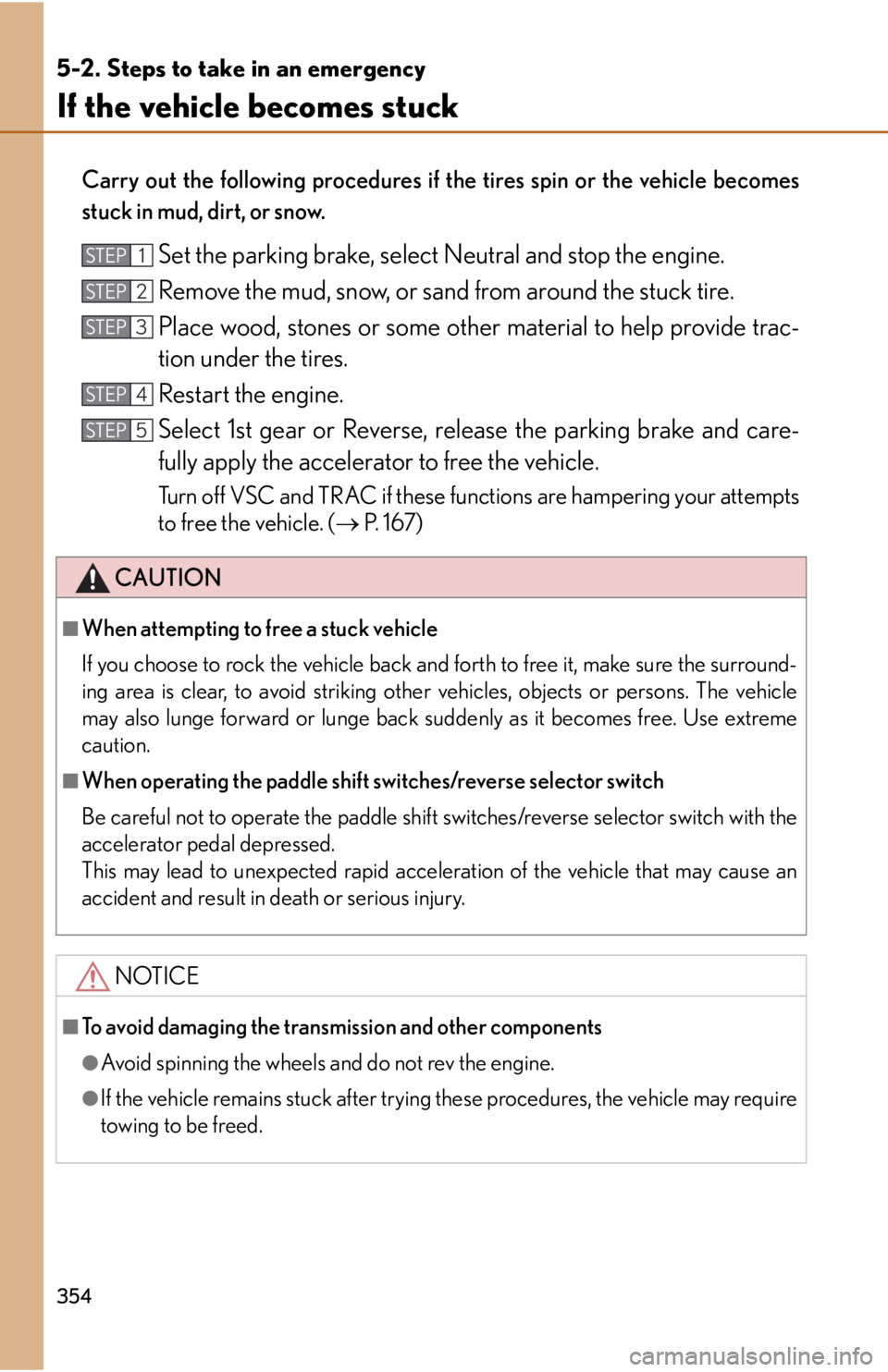Page 334 of 420
332
5-2. Steps to take in an emergency
If you have a flat tire
The LFA is equipped with an emergency tire puncture repair kit, not a spare
tire.
A puncture caused by a nail or screw passing through the tire tread can be
repaired temporarily with the emerge ncy tire puncture repair kit. When
replacing the repaired tire, consult your Lexus dealer or tire dealer.
■Before repairing the tire
●Stop the vehicle in a safe place on a hard, flat surface.
● Set the parking brake.
● Select 1st gear or Reverse.
● Stop the engine.
● Turn on the emergency flashers.
■ Contents
Compressor
Sealant
Injection hose
Extension hose (for extracting
the sealant) Valve core tool
Valve core (spare)
Stickers
Page 345 of 420

5
When trouble arises
343
5-2. Steps to take in an emergency
If the engine will not start
If the engine will not start, even though correct starting procedures are being
followed (
P. 98), consider each of the following points.
■ The engine will not start even when the starter motor operates nor-
mally.
One of the following may be the cause of the problem.
● There may not be sufficient fuel in the vehicle’s tank.
Refuel the vehicle.
● The engine may be flooded.
Try to restart the engine once more following correct starting pro-
cedures. ( P. 9 8 )
● There may be a malfunction in the engine immobilizer system.
( P. 5 3 )
■ The starter motor turns over slowly , the interior lights and headlights
are dim, or the horn does not sound or sounds at a low volume.
One of the following may be the cause of the problem.
● The battery may be discharged. ( P. 3 4 8 )
● The battery terminal connections may be loose or corroded.
■ The starter motor does not turn over, the interior lights and head-
lights do not turn on, or the horn does not sound.
One of the following may be the cause of the problem.
● One or both of the battery terminals may be disconnected.
● The battery may be discharged. ( P. 3 4 8 )
Contact your Lexus dealer if the prob lem cannot be repaired, or if repair
procedures are unknown.
Page 350 of 420
348
5-2. Steps to take in an emergency
If the vehicle battery is discharged
The following procedures may be used to start the engine if the vehicle’s bat-
tery is discharged.
You can call your Lexus dealer, or qualified repair shop.
If you have a set of ju mper (or booster) cables and a second vehicle with a
12-volt battery, you can jump start yo ur Lexus following the steps below.
Open the rear hatch and remove
the battery cover.
If the rear hatch cannot be opened
with the rear hatch opener switch,
use the release cable. ( P. 2 9 )
After removing the positive (+)
battery terminal cover and check-
ing that the negative (-) terminal is
securely fixed in place, connect the
jumper cables in the following
order:
Positive (+) battery terminal on
your vehicle
Positive (+) battery terminal on
the second vehicle
Negative (-) battery terminal on
the second vehicle
Negative (-) battery terminal on
your vehicle
STEP1
STEP2
Page 351 of 420

5
When trouble arises
349
5-2. Steps to take in an emergency
Start the engine of the second vehicle. Increase the engine speed
slightly and maintain at that level for approximately 5 minutes to
recharge the battery of your vehicle.
Maintain the engine speed of th e second vehicle and start the
engine of your vehicle.
Once the vehicle’s engine has started, remove the jumper cables
in the exact reverse order from which they were connected.
After disconnecting the jumper cables, make sure that the negative (-)
battery terminal on your vehicle is fixed securely.
Once the engine starts, have the vehicle inspected at your Lexus dealer
as soon as possible.
■Starting the engine when the battery is discharged
●If the gear indicator is not displayed when an attempt is made to start the
engine, the engine is not yet ready to start. Depress the brake pedal for several
seconds and wait for the ge ar indicator to appear.
●The engine cannot be started by push-starting.
■To prevent battery discharge
●Turn off the headlights and the audio system while the engine is off.
●Turn off any unnecessary electrical compon ents when the vehicle is running at a
low speed for an extended period, such as in heavy traffic.
STEP3
STEP4
STEP5
Page 353 of 420
5
When trouble arises
351
5-2. Steps to take in an emergency
If your vehicle overheats
If your engine overheats:
Stop the vehicle in a safe place and turn off the air conditioning
system.
Check to see if steam is coming out from under the hood.
If you see steam:
Stop the engine. Care fully lift the hood after the steam subsides
and then restart the engine.
If you do not see steam:
Leave the engine running and carefully lift the hood.
Check to see if the cooling fan is
operating.
While being careful of hot air and
exhaust gases, check by looking
through the radiator grilles or by
listening to the operating sound.
If the fan is operating:
Wait until the engine coolant tem-
perature shown on the gauge low-
ers and then stop the engine.
If the fan is not operating:
Stop the engine immediately and
call your local Lexus dealer.
STEP1
STEP2
STEP3
Page 354 of 420
352
5-2. Steps to take in an emergency
After the engine has cooled down
sufficiently, check the engine cool-
ant level and inspect the radiator
core (radiator) for any leaks.
Add engine coolant if necessary.
(P. 362)
Water can be used in an emer-
gency if engine coolant is unavail-
able.
Have the vehicle inspected at the ne arest Lexus dealer as soon as possi-
ble.
STEP4
STEP5
■Overheating
If you observe the following, your vehicle may be overheating.
●The engine coolant temperature gauge flashes or a loss of power is experi-
enced.
●Steam comes out from under the hood.
Page 355 of 420
5
When trouble arises
353
5-2. Steps to take in an emergency
CAUTION
■To prevent an accident or injury when inspecting under the hood of your vehicle
●If steam is seen coming from under the hood, do not open the hood until the
steam has subsided. The engine compartm ent may be very hot, causing serious
injury such as burns.
●Keep hands and clothing away from the drive belt while the engine is running.
●Do not loosen the coolant reservoir cap while the engine and radiator are hot.
Serious injury, such as burns, may resu lt from hot coolant and steam released
under pressure.
NOTICE
■When adding engine coolant
Wait until the engine has cooled do wn before adding engine coolant.
When adding coolant, do so slowly. Adding cool coolant to a hot engine too quickly
can cause damage to the engine.
Page 356 of 420

354
5-2. Steps to take in an emergency
If the vehicle becomes stuck
Carry out the following procedures if the tires spin or the vehicle becomes
stuck in mud, dirt, or snow.
Set the parking brake, select Neutral and stop the engine.
Remove the mud, snow, or sand from around the stuck tire.
Place wood, stones or some other material to help provide trac-
tion under the tires.
Restart the engine.
Select 1st gear or Reverse, release the parking brake and care-
fully apply the accelerator to free the vehicle.
Turn off VSC and TRAC if these functions are hampering your attempts
to free the vehicle. ( P. 1 6 7 )
CAUTION
■When attempting to free a stuck vehicle
If you choose to rock the vehicle back and forth to free it, make sure the surround-
ing area is clear, to avoid striking other vehicles, objects or persons. The vehicle
may also lunge forward or lunge back suddenly as it becomes free. Use extreme
caution.
■When operating the paddle shift switches/reverse selector switch
Be careful not to operate the paddle shift switches/reverse selector switch with the
accelerator pedal depressed.
This may lead to unexpected rapid acceleration of the vehicle that may cause an
accident and result in death or serious injury.
NOTICE
■To avoid damaging the transm ission and other components
●Avoid spinning the wheels and do not rev the engine.
●If the vehicle remains stuck after trying these procedures, the vehicle may require
towing to be freed.
STEP1
STEP2
STEP3
STEP4
STEP5